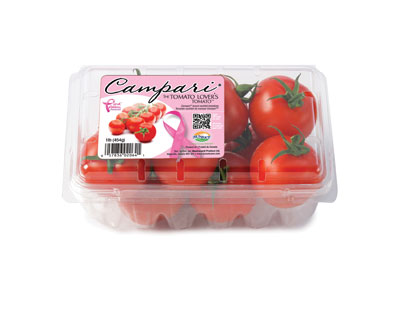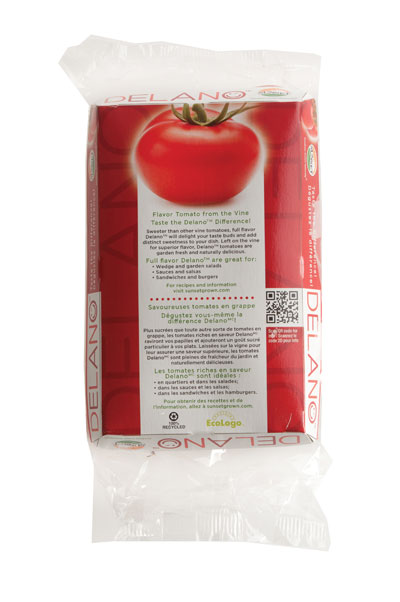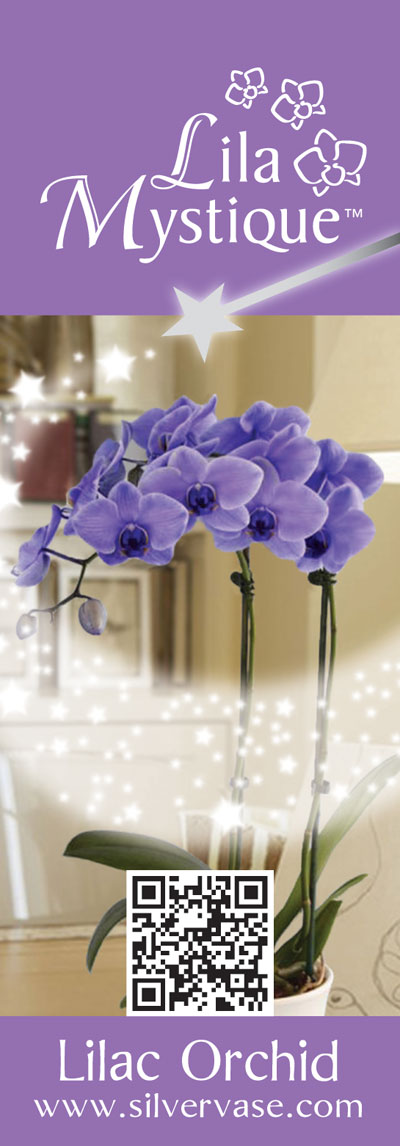
Popular overseas for years, QR (quick response) codes are now making inroads with North American greenhouse operations.
Popular overseas for years, QR (quick response) codes are now making inroads with North American greenhouse operations.
 |
|
Originally used by vehicle manufacturers as a way to track parts, the codes are now being used by companies to connect with customers and potential customers in a wide variety of ways – and to get a better sense of what consumers out there are interested in. By simply snapping a photo of the code, smartphone users who are browsing in a greenhouse or store are connected to an associated webpage – and what that webpage may contain is where the vast potential of the QR code comes into play.
The ways in which the technology can be used was brought to the attention of Mastronardi Produce in Kingsville, Ontario, early last year through its labelling and marketing partners.
“They showed us the possibilities QR offers, such as driving traffic to your website, informing the consumer both nutritionally as well as suggesting usage through recipes,” says Joe Sbrocchi, Mastronardi’s vice-president of sales, marketing and planning. “In general, it helps to create a greater presence for your business.”
Sbrocchi says his company sees QR codes as “a powerful avenue” for communicating with the end-consumer.
“There are a lot of options now that weren’t there at first – you can tie the codes into contests, recipes, and it’s also another really good opportunity to tell our story,” he explains.
TAGS A GREAT WAY FOR MARKETERS TO “CLOSE THAT KNOWLEDGE GAP”
■ “We have many environmentally friendly initiatives, such as a carbon-negative greenhouse, and it’s another way to tell people about it and close that knowledge gap.”
 |
|
| QR codes offer a growing number of marketing options, notes Joe Sbrocchi of Mastronardi Produce. PHOTOS COURTESY MASTRONARDI PRODUCE |
Mastronardi’s use of QR codes actually began late last year with a weblink unrelated to its products – the codes were part of the company’s “Pink Ribbon” SUNSET Campari Campaign (see photo).
“It allowed customers to find out more about the campaign and we were impressed with the positive response,” says Sbrocchi.
In addition to having QR codes on their SUNSET Campari labels, Mastronardi now also has them on SUNSET Delano tomatoes, One Sweet Cucumber, and One Sweet Peppers.
“As we move into new packaging and pack-styles over the coming year, we will try to include them on almost all our packaging,” Sbrocchi notes. “We see a whole world of opportunity.”
He says they’ll be able to get a better sense of things – such as ROI, usage and customer feedback – over the next year to 18 months.
TAKING A CLOSER LOOK AT QR POTENTIAL
■ When asked about the potential value of QR codes, greenhouse marketing specialist Laura Brinkmann says, “it’s safe to assume that anything that drives the customer towards your marketing is ultimately a win-win.”
Brinkmann, who is the marketing coordinator at the Ontario Greenhouse Vegetable Growers (and is also responding on behalf of the Canadian Horticultural Council), notes that while her association has not done any specific research on the technology, “it’s safe to assess from the sheer media attention toward QR codes that customers are indeed interested in this new technology.
“Now, that doesn’t mean in a year or two there won’t be a new technology … but for now, QR codes are the latest.”
She says the technology provides benefits to consumers that go beyond easy access to company and product information.
“While our sector already has a traceability system in place, QR codes can work to identify that system to the customer,” she asserts. “When a customer can walk up and scan a code with their phone and be brought directly to the marketer or grower’s website, it adds a distinct element of transparency.”
TECHNOLOGY’S POTENTIAL TO BOOST SPENDING
■ Brinkmann says the technology has the potential to boost spending.
 |
|
| Silver Vase is one of the most innovative potted plant growers in North America. It works closely with Dutch breeder Floricultura, and makes extensive use of QR coding. |
“QR codes can provide distinct advantages as they can (help consumers) relate the product to a recipe – perhaps a recipe highlighting even more products from that company, and thus promote further sales,” she says.
However, although she also has yet to study QR codes, Dr. Isabelle Lesschaeve has extensively studied other potential purchasing triggers, and isn’t sure the existence of a code will affect sales significantly.
“This industry has a lack of understanding of what triggers a purchase in a greenhouse or garden centre,” notes the leader of the Consumer Insights and Product Innovation team at the Vineland Research and Innovation Centre (a not-for-profit initiative located in Vineland, Ontario).
“Flowering plants for example, are a hedonistic ‘pleasure’ product, and their purchase is very subjective and personal, with look and price being most important.”
Lesschaeve points out that older consumers may not even realize that QR codes are something more than a new type of bar code.
A MAJOR INVESTMENT; BUT IS IT WORTH IT?
■ “Younger people may use them in deciding whether to purchase one plant over another, but I’m not sure whether the presence of a QR tag itself would trigger a sale over a plant that has no QR code on its tag,” she says. “People do web searches on things all the time, and while QR codes are convenient, I’m not sure the cost and time to create a QR system would be worth it. Every consumer is different – some prefer to go online and read or see videos, and some people want interaction with a person and only usually patronize nurseries that offer a lot of help.”
In October 2011, Florida-based Silver Vase started adding QR codes to its plant tags (see photo), connecting customers with detailed plant care information on specific pages of the Silver Vase website.
“We’re always looking for new innovations that enhance our products’ appeal … and we had been monitoring QR code adoption rates both here and abroad for some time before we incorporated them on our tags,” says director of marketing Marcella Lucio.
“For us, the biggest challenge was ensuring that our QR codes functioned on multiple platforms, phone types, paper types, etc. We discovered that this was affected by the size, quality and even how and where the QR code was created.”
Her advice to those looking at QR codes? “Test, then retest, then test again.”
ALWAYS A LEARNING CURVE WITH ANY NEW TECHNOLOGY
■ Silver Vase has been very pleased with the positive response to the codes. “Of course, with any new technology there is always a learning curve,” notes Lucio, “and as more and more consumers become familiar with QR codes and their convenience and potential, we expect even more positive results.”
In December, Emerald Coast Growers of Florida started using QR codes in a few of their ads, one that links people with its website homepage and another for the mobile version of their website.
President Paul Babikow notes that since both versions of the site already have specific plant product pages, tying codes to the websites has “potential,” but adds that, “we would not likely use QR tags with plants, since our product is used by growers to bump up and produce for finished, but they could definitely be a marketing tool in our print ads.”
In terms of gauging response, the company has yet to set up a system to track hits from the use of QR.
Along with her cautions, Lesschaeve says this kind of technology is here to stay.
“Consumers will demand more and more quick ways of getting information about all consumer goods,” she says.
“If they find something like QR codes valuable and convenient, they will use them, but companies must do well at facilitating consistent and reliable access to information. You need people to be dedicated to the project, and the company has to be 100 per cent committed to the investment.”
Treena Hein is a freelance writer in Ontario.
Print this page